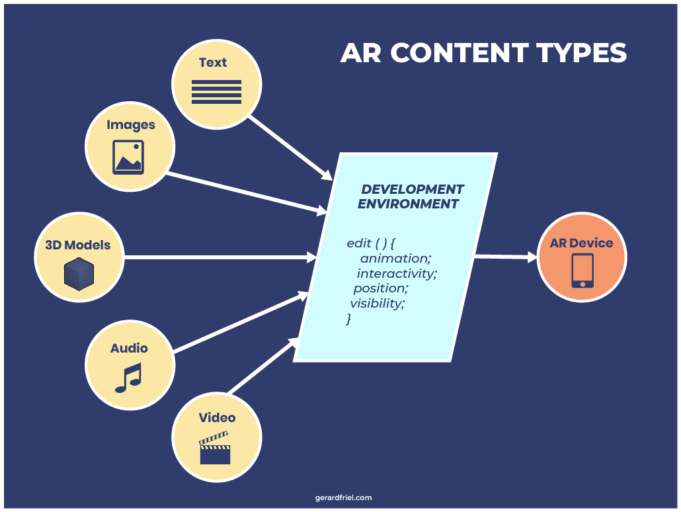What goes into an AR experience?
Augmented Reality (AR) experiences contain digital objects positioned in a user’s environment that can be configured to allow interaction. When building an AR experience, you typically import five key content types into a software program and produce a digital product that can be accessed via an AR enabled device such as a smartphone or tablet. There are five key content types that make up an AR experience.
5 Key Content Types of AR
- Text
- Images
- 3D Models
- Audio
- Video

Text
Text is used as part of the user interface (UI), incorporated into buttons and used within information panels giving the user context or further information. Commonly used within boxes overlaying the AR experience, text can also be used within panels that are part of the actual 3D environment.
Images
Standard 2D images can be included in AR experiences. Images can be displayed in the AR device’s native image viewer, be part of the UI, or appear as buttons that permit interactivity with the digital content. Button images can also be included within the 3D environment by adding it to plane’s surface. Adding controls in this diegetic manner increases engagement and presence for users within the AR experience.
3D Models
One of the benefits of AR is being able to insert 3D models into the user’s environment. You can build your own 3D models using the main programs of Maya, 3ds Max or Cinema 4D. You can also create 3D models using a free open source program called Blender. Alternatively, you can source free or paid models to import using the numerous online market places. Due to the limited resources (such as memory and processing power) available in current AR devices, it’s best practice to use 3D models that have been highly optimised and contain a low poly count.
Video
Video files can be included in AR. Videos can be launched and played in the AR device’s native video player or within the 3D environment by projecting the video on a 3D plane to mimic an actual TV screen. Videos that use alpha transparency can also be used for a for a hologram effect. Ideally, video files can be streamed from an online source, otherwise they should be optimised with the minimal file size as possible.
Audio
Audio as soundtracks or sound effects can be included in AR. A benefit of AR is the ability to include spatial audio, where sounds are played depending on your location. It can provide information based on your GPS position and provide recommendations, play immersive soundtracks with instruments in differing locations, or allow you to encounter location-based storytelling.
Development environment
Once you have your content or raw materials, you can use a development environment or software package to bring your ideas to life through animation and interactivity. Software that allows to work in AR include the main game engines of Unreal, and Unity, along with specialist software such as Vuforia, Zapworks, and Wikitude. Apple and Google have their own AR Software Development Kits (SDKs). Apple’s ARKit and Google’s ARCore can be used to develop native AR apps for release in their respective app stores.
AR Devices
Augmented reality can be consumed on a number of devices. The most prevalent AR devices at present are smartphones and tablets where AR content is accessed via apps or within the mobile browser using WebAR. Other form factors include larger headsets such as the Hololens 2 which has greater computing power but is rather cumbersome to wear for long periods. Until lighter ‘smart glasses’ become available, most AR content will be consumed using modern smartphones that take advantage of built in support of AR technology.
Summary
When creating AR experiences, there are 5 key content types that can be included. They are text, images, 3D models, audio and video. By using a development environment, these content types can be combined with animation and interactivity to provide users with a compelling AR experience delivered straight to their smartphone.
